Related Research Articles

Jackson County is a county located in the U.S. state of Ohio. As of the 2020 census, the population was 32,653. Its county seat is Jackson. The county is named for Andrew Jackson, a hero of the War of 1812 who was subsequently elected President of the United States. It is known as "The Little Wales of Ohio." Jackson County comprises the Jackson, OH Micropolitan Statistical Area.

Russell is a home rule-class city on the south bank of the Ohio River in Greenup County, Kentucky, United States. The population was 3,380 as of the 2010 census, down from 3,645 in 2000. Russell is a suburb of Ashland and part of the Huntington-Ashland-Ironton metropolitan area. It has close economic affiliations with its neighbors, Ashland and Flatwoods in Kentucky and Ironton, Ohio.

Ironton is a city in and the county seat of Lawrence County, Ohio, United States. Located in southernmost Ohio along the Ohio River, it is 20 miles (32 km) northwest of Huntington, West Virginia. The population was 10,571 at the 2020 census. Ironton is part of the Huntington–Ashland metropolitan area.

The Toledo, Cincinnati and St. Louis Railroad (TC&StL) was a 3 ft narrow-gauge railroad based in Ohio. It began as a subsidiary of the 3 ft narrow-gauge Toledo, Delphos and Burlington Railroad (TD&B), which was opened on July 4, 1875, but in 1882 the two companies merged and retained the TC&StL name, which was more descriptive of its extent.
Ohio University Southern Campus is a satellite campus of Ohio University in Ironton, Ohio. The campus also has an extension in Proctorville, Ohio, and the Ohio Horse Park in Franklin Furnace, Ohio.

Col. James M. Schoonmaker, formerly Willis B. Boyer, is a lake freighter that served as a commercial vessel on the Great Lakes for much of the 20th century. Named for Medal of Honor recipient James Martinus Schoonmaker, it is currently a museum ship in Toledo, Ohio.

Cornwall Iron Furnace is a designated National Historic Landmark that is administered by the Pennsylvania Historical and Museum Commission in Cornwall, Lebanon County, Pennsylvania in the United States. The furnace was a leading Pennsylvania iron producer from 1742 until it was shut down in 1883. The furnaces, support buildings and surrounding community have been preserved as a historical site and museum, providing a glimpse into Lebanon County's industrial past. The site is the only intact charcoal-burning iron blast furnace in its original plantation in the western hemisphere. Established by Peter Grubb in 1742, Cornwall Furnace was operated during the Revolution by his sons Curtis and Peter Jr. who were major arms providers to George Washington. Robert Coleman acquired Cornwall Furnace after the Revolution and became Pennsylvania's first millionaire. Ownership of the furnace and its surroundings was transferred to the Commonwealth of Pennsylvania in 1932.

David Sinton was an Irish-born American pig-iron industrialist, born in County Armagh, Ireland, who became one of the wealthiest people in America.

The Ironton Railroad was a shortline railroad in Lehigh County, Pennsylvania. Originally built in 1861 to haul iron ore and limestone to blast furnaces along the Lehigh River, traffic later shifted to carrying Portland cement when local iron mining declined in the early 20th century. Much of the railroad had already been abandoned when it became part of Conrail in 1976, and the last of its trackage was removed in 1984.

John Means was a mayor of Ashland, Kentucky and a leader in the banking and iron industries. He helped organize the Cincinnati and Big Sandy Packet Company, laid out Ashland Cemetery, built furnaces, served as vice-president of the Ashland National Bank, and served then led the growing iron business of the Means family. The Kentucky Encyclopedia of 2015 described the Means-owned iron empire as having "created massive enterprises out of the disorganized and weakened industry that emerged from the Civil War."

Thomas Williamson Means was a settler of Hanging Rock, Ohio, and a native of South Carolina. Together with his brother Hugh he became notable in Ashland, Kentucky, after he built the Buena Vista Furnace and became a director of the Kentucky Coal, Iron & Manufacturing Company. He was also the father of Ashland Mayor John Means. Means owned furnaces in Alabama, Kentucky, Ohio, and Virginia.

William Menelaus was a Scottish-born mechanical engineer, who made his name and fortune as the works manager at the Dowlais Ironworks in South Wales.

New Birmingham is an abandoned town-site in central Cherokee County, Texas, now a ghost town. New Birmingham once seemed destined to be a major industrial mecca in the heart of east Texas. Lying just off U.S. Highway 69, the site was about two miles southeast of the county seat of Rusk, Texas.

The Ironton Norfolk and Western Depot is a former train station in downtown Ironton, Ohio, United States. Constructed at the beginning of the twentieth century, it served the transportation needs of its community for more than half a century, and it has been named a historic site because of its place in local history.

The SS St. Marys Challenger is a freight-carrying vessel operating on the North American Great Lakes built in 1906. Originally an ore boat, she spent most of her career as a cement carrier when much larger ore boats became common. After a 107-year-long working career as a self-propelled boat, she was converted into a barge and paired with the tug Prentiss Brown as an articulated tug-barge. Before conversion, she was the oldest operating self-propelled lake freighter on the Great Lakes, as well as being one of the last freight-carrying vessels on the Great Lakes to be powered by steam engines.

The Ohio Southern Railroad operated between Ironton, Ohio, and Lima, Ohio, from 1893 and 1905. Beginning in 1878 as the narrow gauge Springfield, Jackson and Pomeroy Railroad, it ran from Jackson-Wellston, Jackson County to Springfield, Ohio. The line was converted to a standard gauge by 1880 and renamed the Ohio Southern Railroad in 1881. From Jeffersonville, branch lines were started towards Columbus to the northeast and Cincinnati to the southwest, but never completed. By September 1893, the Ohio Southern had reached north to Lima with a bridge over the Great Miami River at Quincy. At Lima, the freight could link to the Lima Northern Railway for points further north. In 1898, the Lima Northern became the Detroit and Lima Northern Railroad (D&LN). Ohio Southern depots continue to stand in St. Johns, Uniopolis, Jackson Center, Quincy, and Rosewood.
Jane Alden Stevens is an American photographer and educator. Solo exhibitions of her work have been mounted at the ARC Gallery in Chicago, the Herbert F. Johnson Museum of Art in Ithaca, NY, and the Pittsburgh Filmmakers Gallery. She has exhibited extensively abroad, including in Finland, Ukraine, Belgium, Germany, and Brazil. Stevens’ photographs are included in the permanent collections of the George Eastman House International Museum of Photography and Film in Rochester, NY, the Cincinnati Art Museum, and the Museu da Imagem e do Som in São Paulo, Brazil. She is Professor Emerita of Fine Arts at the University of Cincinnati.

Henry Chisholm was a Scottish American businessman and steel industry executive during the Gilded Age in the United States. A resident of Cleveland, Ohio, he purchased a small, struggling iron foundry which became the Cleveland Rolling Mill, one of the largest steel firms in the nation. He is known as the "father of the Cleveland steel trade".

Eugene Zimmerman was an American industrialist and railroad owner. He amassed great wealth as a stockholder or shareholder in John D. Rockefeller's Standard Oil. He used the income from his Standard Oil holdings to invest in railroads.

SS Sir William Siemens was a steel-hulled American lake freighter in service between 1896 and 1944. Built in 1896 by the Globe Iron Works Company of Cleveland for John D. Rockefeller's Bessemer Steamship Company, she was the third of three 432 ft-long (131.7 m) lake freighters, each of which shared the unofficial title of Queen of the Lakes due to their record-breaking length.
References
- 1 2 3 4 "KELLY FAMILY". www.lawrencecountyohio.com. Archived from the original on 2001-12-24.
- ↑ "Wayne National Forest - Home" (PDF). Fs.fed.us. 2019-10-11. Retrieved 2019-10-16.
- ↑ Nannie Kelly Wright, compiled and edited by Virginia S. Bryant, Lawrence County Historical Society, 1989
- ↑ "Center Furnace". www.irontonfurnaces.com. Retrieved Oct 16, 2019.
- ↑ "Lawrence County, Ohio Genealogy and History". www.lawrencecountyohio.com. Archived from the original on 2004-02-25.